|
LEXINGTON, Ky. – EM’s Depleted Uranium Hexafluoride (DUF6) Conversion Project completed several plant modifications at its Portsmouth, Ohio and Paducah, Kentucky facilities to improve their safety and reliability.
“These plant upgrades will increase worker safety while improving productivity at our conversion plants,” said Robert Edwards, manager of EM’s Portsmouth/Paducah Project Office (PPPO). “It represents time and effort well spent in preparation for the safe and deliberate restart of facilities.”
The DUF6 Project addresses the nation’s legacy of six decades of uranium enrichment operations at DOE gaseous diffusion plants at Portsmouth, Paducah, and Oak Ridge, Tennessee. The project converts the DUF6 byproduct, currently stored in cylinders at Portsmouth and Paducah, to a more stable oxide form for reuse or disposal.
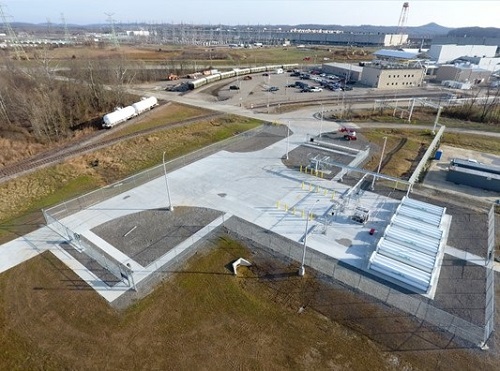 |
|
Pictured is the bulk-hydrogen project installation at the Portsmouth Site. This backup system for producing hydrogen was among several plant modifications EM’s Depleted Uranium Hexafluoride Conversion Project completed during the past year. |
A closeup of a backup scrubber with new pipes in Paducah’s Process Offgas System, one of several modifications EM’s Depleted Uranium Hexafluoride Conversion Project made to improve safety and reliability in the past year. |
|
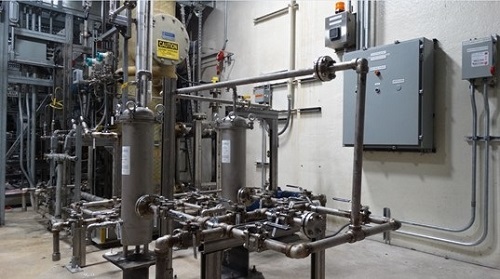 |
 |
|
EM’s Depleted Uranium Hexafluoride (DUF6) Conversion Project installed permanent maintenance access platforms to replace scaffolding in the Oxide Powder Handling Hopper Rooms. The platforms improve access for maintenance and operation workers at both DUF6 plants. |
Among the improvements at both sites are new backup systems and improved piping to reduce the possibility of worker injury, plant outages, or chemical leaks.
The backup system is for producing hydrogen when the primary system is offline. Hydrogen is a necessary component of the conversion process. The new stainless steel piping reduces the possibility of potassium hydroxide leaks.
Other improvements intended to further improve worker safety include permanent maintenance access platforms to replace scaffolding in the Oxide Powder Handling Hopper Rooms, and new maintenance isolation valves in the hydrogen fluoride storage system.
Zack Smith, president and project manager for PPPO operations and maintenance contractor Mid-America Conversion Services, said United Steel Workers (USW) input was essential to the projects’ successful completion.
“USW worker feedback was fundamental in targeting areas for improvement that provided the greatest return on employee safety,” Smith said. “We recognize that the workforce is our most valuable asset and will continue to put safety first."
DUF6 Project safety accomplishments in the last year include shipping 2.3 million gallons of hydrogen fluoride for commercial reuse, completing 24,000 required storage-cylinder inspections, and processing 69 non-standard DUF6 cylinders.
-Contributor: Kearney Ackermann, Brad Mitzelfelt
 In this July 2019 photo, Janice Lawson, deputy vice president of EM operations for Savannah River Nuclear Solutions, speaks to the Savannah River Site NRU/NRX Removal Team at a celebration after the team completed the receipt of spent nuclear fuel from Canada, the largest removal of spent nuclear fuel from another nation to the U.S.
More than 100 Savannah River Site (SRS) federal and contractor employees, many of whom work in EM facilities, have been honored with Secretary of Energy Achievement Awards for accomplishments in 2019 in support of the Department’s mission and the benefit of the nation.
“We are proud to announce that SRS employees are recognized as contributors to Achievement Award-winning teams,” SRS Manager Mike Budney said. “These exceptional employees deserve both our congratulations and our thanks.”
The awards represent some of the highest internal, non-monetary recognitions that DOE employees and contractors can receive.
Teams honored with Achievement Awards included EM employees from SRS:
National Research Universal (NRU) and National Research Experimental (NRX) Highly Enriched Uranium Removal Team
A National Nuclear Security Administration (NNSA) nonproliferation mission, the NRU/NRX highly enriched uranium campaign represented the largest removal of spent nuclear fuel from other nations to the U.S. EM workers supported the receipt and safe storage of the material in the L Area Disassembly Basin at SRS. Spent nuclear fuel is received and stored safely underwater in the basin.
The L Area Disassembly Basin began receiving highly enriched uranium from Chalk River Laboratories in Canada starting in 2015. The effort involved 56 truck shipments from Canada covering more than 66,000 miles. The campaign was completed 12 months ahead of schedule.
“This campaign involved receiving a different type of fuel that was longer and heavier than what the current system was set up for,” said Neil McIntosh, L Area deputy facility manager for Savannah River Nuclear Solutions (SRNS), the management and operations contractor at SRS. “A lot of preparation and modifications to the facility had to be performed before we could start receipt.”
Employees completed other activities to prepare for receipt of the spent nuclear fuel, including developing new procedures, training operators in a mock-up facility, and performing a readiness assessment.
“I thank the employees of L Basin for helping to make this campaign a success,” NNSA U.S. Nuclear Material Removal Program Manager Jeff Galan said. “Their commitment to doing the work to ensure safe and timely receipts was essential to the program.”
The Seattle Response and Recovery and Cs-137 Joint Investigation Teams
Fourteen EM employees at SRS were part of a large team recognized for the successful emergency response, recovery, stabilization, and investigation of a breached radioactive source at the University of Washington’s Research and Training Building.
EM employees involved in this work included members of the Radiological Assistance Program, employees skilled in the construction of radiological containment structures, and a technical consultant from EM’s Savannah River National Laboratory.
“Each of the employees recognized plays an invaluable role in helping to make the world safer,” Budney said. “The recognition of these teams affirms our commitment to the safety and security of our nation.”
-Contributor: Lindsey MonBarren
Use of replica components of the Integrated Waste Treatment Unit at the Idaho National Laboratory Site has proven effective in readying the facility for actual waste treatment.
IDAHO FALLS, Idaho – EM’s use of replica components of a liquid waste treatment facility at the Idaho National Laboratory (INL) Site has proven effective in preparing for the facility’s active operations.
Diversified Metals, an Idaho Falls-based metal fabrication shop, erected a mock-up to prepare radiation protection technicians and operators with Fluor Idaho, EM’s INL Site cleanup contractor, for radiological work once the Integrated Waste Treatment Unit (IWTU) is operating.
“Using this mock-up not only allows our teams to develop and perfect the procedures they’ll use once the facility is processing actual waste, it also helps the teams develop safety measures and build in radiological controls,” Fluor Idaho IWTU Project Safety Manager Allen Nellesen said.
The IWTU was constructed to treat the remaining approximately 900,000 gallons of liquid waste from a nearby tank farm at the INL Site that accepted rinse water and other effluents from historic spent nuclear fuel reprocessing runs at the Idaho Nuclear Technology and Engineering Center. So far, the facility has treated more than 225,000 gallons of a simulant of the liquid waste in six demonstration runs.
Diversified Metals also built a mock-up to test flow control valves necessary for transferring liquid waste during operations. Engineers created a liquid slurry containing water and sand particles to simulate the liquid sodium-bearing waste that the IWTU was constructed to convert to a granular solid. The slurry was pumped through the valves to ensure they wouldn’t plug. Both the particle size and flowrate were modified during testing.
Nellesen said the tests using a mock-up were a success.
“We were able to determine that the valves will perform as designed and no flow restrictors would be needed,” he said.
 Several major components of the Integrated Waste Treatment Unit, such as its primary reaction vessel, pictured here, have benefited from the use of mock-ups constructed to test new designs and materials.
Diversified Metals also conducted mock-up testing on a decontamination system for dissolving dried waste in the Denitration Mineralization Reformer (DMR) — IWTU’s primary reaction vessel — and transferring the material to a holding tank.
The resulting slurry from that system would then be mixed in the tank to reduce its particle size to less than 800 microns — about twice the size of large coffee grounds — and eventually reinjected into the DMR.
Previously, the IWTU team used a mock-up of the DMR to test the facility’s auger-grinder, which pulverizes chunks of treated material and transfers the particles to other processes.
“We were able to test a more robust design for the auger-grinder using the mock-up and we knew in advance of installing it in the IWTU that it would be much more effective than previous designs,” Nellesen said. “Three demonstrations runs at the IWTU proved what we had learned in testing using the mock-up. We now have an auger-grinder that operates as designed.”
Following several modifications, the facility is scheduled to begin a 50-day confirmatory run this summer. Actual waste treatment will follow after readiness actions are complete.
-Contributor: Erik Simpson
EM has joined forces with the DOE Office of Legacy Management (LM) to expand the EM National Laboratory Network to support the missions of both program offices: legacy nuclear waste cleanup and long-term stewardship of closure sites.
EM Acting Assistant Secretary William “Ike” White and LM Director Carmelo Melendez recently chartered the renamed group called the Network of National Laboratories for Environmental Management and Stewardship (NNLEMS).
“We recognize the special relationship of national labs as federally funded research and development centers (FFRDCs) with the government and the value of national labs’ technical support to the success of the EM and LM programs,” White said.
Established in 2017, the EM National Laboratory Network consisted of the Savannah River, Idaho, Los Alamos, Oak Ridge, Pacific Northwest, and Sandia national laboratories. The network served to advise DOE on policy decisions on environmental cleanup and assist DOE in solving emerging and recalcitrant issues. These labs have significant EM-sponsored capabilities and are located near large EM cleanup sites, including Hanford, Savannah River, Idaho, Oak Ridge, Los Alamos, and the Waste Isolation Pilot Plant.
The newly expanded network includes five additional national labs: Argonne, Brookhaven, and Lawrence Berkeley national laboratories; National Energy Technology Laboratory; and SLAC National Accelerator Laboratory.
“This expansion of the lab network will benefit both EM and LM because of the close relationship and synergy between the EM and LM mission activities,” Melendez said.
The expanded lab network is chaired by Vahid Majidi, director of Savannah River National Laboratory, EM’s corporate lab, and co-chaired by another lab director or deputy lab director on a rotating basis. The current co-chair is Los Alamos National Laboratory Director Thom Mason.
“Increasing integration of all aspects of our network to develop comprehensive solutions for environmental cleanup and long-term stewardship is our goal,” Majidi said. “Nuclear environmental cleanup projects start in EM and transition to LM for monitoring, maintenance of remedies, and continued operation of treatment systems such as for groundwater that were implemented by EM.”
Ming Zhu, EM senior advisor for laboratory policy and EM liaison to NNLEMS, says the expanded network works with EM and LM headquarters and site offices to identify and coordinate resources for addressing emergent technical issues, independent technical reviews, strategic planning, technical analysis to support policy development and stakeholder engagement, collaboration with DOE contractors, and implementation of end-state contracting activities.
According to LM, the combined NNLEMS will benefit from the dynamic energy and successes of ongoing LM support. Melendez envisioned the NNLEMS activities with the goal of reducing risks at LM’s highest risk sites. LM and participating national labs have responded to his challenge to identify science and technology solutions, resulting in specific and actionable recommendations for LM sites in Shiprock and Bluewater, New Mexico; Tuba City and Monument Valley, Arizona; and Fernald, Ohio.
The collaboration of the national laboratories in EM and LM activities has resulted in recommendations that improve efficiency, improve communication with stakeholders and regulators, and improve responsiveness to Congress.
-Contributor: Debbie Barr, David Sheeley
 EM tank operations contractor Washington River Protection Solutions last fall completed installation of an evapotranspiration basin, which will collect and evaporate water drained from a high-density, modified asphalt barrier that will be installed this year at Hanford’s TX Tank Farm.
RICHLAND, Wash. – EM’s Office of River Protection (ORP) tank operations contractor, Washington River Protection Solutions (WRPS), has awarded a subcontract worth about $14.5 million to construct a protective barrier above another group of large underground waste storage tanks at the Hanford Site.
Fowler General Construction, based in Richland, will install three sections of high-density, modified asphalt to form one large barrier over 18 tanks that make up the TX Tank Farm. Field work is expected to begin in March and be completed by the end of September.
“The surface barrier protects the environment by preventing rain and snowmelt from permeating into the soil and driving existing contaminants closer to groundwater,” said Richard Valle, ORP program manager for the project.
Constructed between 1947 and 1948, TX is the largest of Hanford’s 12 single-shell tank farms and will be the fourth tank farm with a surface barrier. The barrier will cover more than 220,000 square feet. Last fall, WRPS installed a stormwater collection system and a lined evapotranspiration basin to collect and evaporate water that drains from the barrier.
“The barriers are important for continued safe storage of tank waste,” said David Vasquez, WRPS project manager. “They improve tank and soil stability, and they significantly reduce surveillance and maintenance costs. Furthermore, they provide a safe, clean and stable platform for workers in the farm for years to come.”
The barrier will be constructed under an agreement between DOE, the Washington State Department of Ecology, and U.S. Environmental Protection Agency.
-Contributor: Mark McKenna
Diversion Box 5 is one of two structures in F Tank Farm at the Savannah River Site that EM plans to fill with grout starting next year.
AIKEN, S.C. – EM is moving closer to closing the first Savannah River Site (SRS) tank farm structures since the closure of an underground waste tank in April 2016.
EM and SRS liquid waste contractor Savannah River Remediation received initial federal and state regulatory concurrence to begin the process leading to operational closure of the structures. The South Carolina Department of Health and Environmental Control and U.S. Environmental Protection Agency have preliminarily agreed that no additional waste removal from the structures is necessary, and that EM may continue to proceed with the formal closure process.
The two structures are known as Diversion Boxes 5 and 6. They are a center of activity, similar in concept to an interstate highway’s on- and off-ramps. Each box can connect waste tanks to numerous destinations by way of a series of nozzles and piping that direct radioactive liquid waste between waste tanks or between a waste tank and a facility.
The diversion boxes have been out of operation for more than 30 years. Both are about 15 feet long, 11 feet wide, and 18 feet deep, and they sit on approximately 4-foot-thick concrete slabs about 100 yards apart in the heart of F Tank Farm, one of two tank farms at SRS. There are a total of 14 diversion boxes in the tank farms.
The next phase for Diversion Boxes 5 and 6 is to prepare formal documentation, which will include an opportunity for public comment, leading to a final decision by the agencies that the diversion boxes can be operationally closed by filling them with a cement-like grout.
Isolating the boxes and obtaining necessary regulatory approvals for grouting is targeted for completion this year. EM is aiming to start filling the boxes with grout in 2022. Diversion Box 5 will require about 94 cubic yards — or about 12 truckloads — of grout; Diversion Box 6, which is slightly larger, will require nearly 113 cubic yards of grout.
DOE-Savannah River Assistant Manager for Waste Disposition Jim Folk said the operational closure of the diversion boxes is another positive step for the site's liquid waste mission.
"Cleaning and grouting structures that have either contained or facilitated the flow of radioactive waste are important actions that help fulfill the overall closure mission," Folk said. “Operational closure of these diversion boxes is a significant step toward our overall plan for deactivation and eventual closure of the entire F Tank Farm.”
Operational closure is a detailed process, as regulatory agencies review plans to ensure thoroughness and safety of the entire process, focusing on safety to human health and the environment for the long term. Closure of the diversion boxes, along with operational closure of waste tanks and other structures, ultimately leads to closure of the entire F Tank Farm.
SRR President and Project Manager Phil Breidenbach said preliminary regulatory concurrence to move forward with operational closure is a significant step in the process of closing diversion boxes and waste tanks.
"Moving forward with another important operational closure would never happen without exceptional teamwork with the state, DOE, and within SRR, " Breidenbach said. "Each step we take moves us one step closer to completing our mission, which is to safely eliminate the greatest environmental hazard in South Carolina. I’m proud of this team and the work we’re doing.”
-Contributor: Jim Beasley
RICHLAND, Wash. – Following an arduous certification process, an emergency preparedness specialist with EM contractor Hanford Mission Integration Solutions is the only Hanford Site employee to hold a prestigious associate emergency manager (AEM) credential.
Following more than a decade of experience in emergency management, Amanda Lee completed 200 hours of classroom training, supplied a written narrative demonstrating her comprehensive knowledge and expertise on emergency management, and completed a proctored exam that assessed her knowledge in the field.
“Emergency preparedness is the first line of defense for any unexpected crisis or disaster,” Richland Operations Office Emergency Management Lead Lori Peters said. “Having a certified professional as part of the Hanford Site team increases our readiness to successfully respond to any emergency with professionalism and efficiency.”
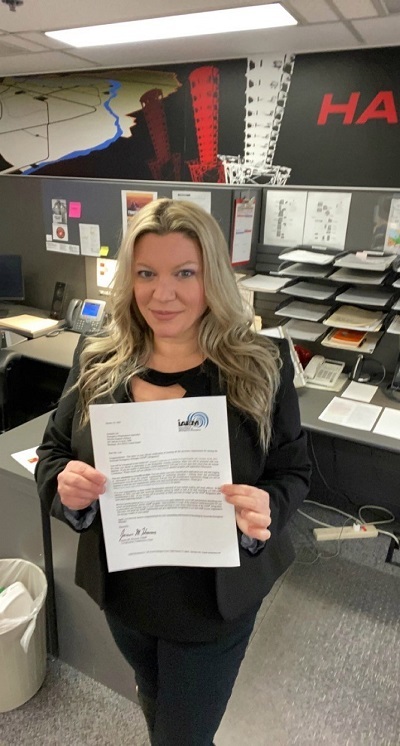 |
|
Emergency preparedness specialist Amanda Lee displays her certification notice inside the Hanford Emergency Operations Center; the letter declares she is now recognized as an associate emergency manager for the International Association of Emergency Managers, a certification awarded to only 3,000 people in the last 25 years. |
Amanda Lee directs a briefing for an exercise on the Hanford Site following her certification as an associate emergency manager after completing a lengthy training and testing process. |
|
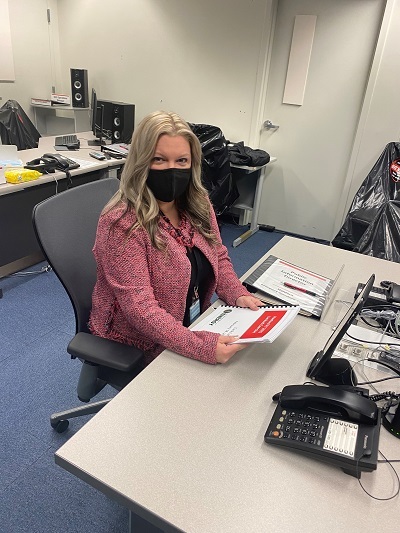 |
Lee received her AEM certification recently from the International Association of Emergency Managers, a global organization dedicated to emergency management. She joins about 3,000 emergency managers who have received the AEM credential worldwide in the past 25 years.
Lee previously served as a 911 dispatcher, including emergency response to flooding and natural cover fires.
“My experience taught me that effective emergency management and mitigation are an essential part of protecting people and our community,” Lee said. “After completing my Master of Science in leadership with an emphasis in disaster preparedness and executive fire leadership, I wanted to use what I had learned to serve as an authentic leader in the field of emergency management and empower and inspire others.”
Lee’s manager, Cathie Carter, said, “Amanda’s professionalism and experience proved invaluable during the successful response to the partial collapse of a waste storage tunnel in 2017, and she ensures Hanford’s emergency response capabilities are maintained and validated.”
-Contributor: Robin Wojtanik
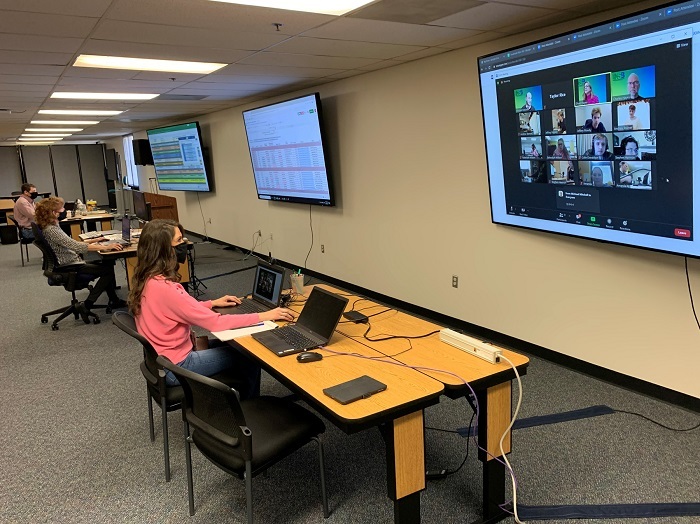 Savannah River Nuclear Solutions employees, from left, Tim Arnold, Kim Mitchell, and Taylor Rice work in the control center for the DOE Savannah River Regional Science Bowl competition, remotely coordinating the day-long event on Feb. 20.
AIKEN, S.C. – Future scientists, engineers, and mathematicians tested their knowledge during the annual DOE Savannah River Regional Science Bowl competition on Feb. 20. The virtual event attracted 18 teams from the Savannah River Site (SRS) area.
Lakeside High School in Evans, Georgia won the regional event and earned the honor to compete in the DOE National Science Bowl to be held virtually in May.
Second place went to the team from the South Carolina Governor’s School for Science and Mathematics, Hartsville, South Carolina, while Nation Ford High School of Fort Mill, South Carolina took third place.
During the day-long regional Science Bowl, tension and excitement were evident as team members knew every correct answer they provided to questions in the competition brought them a step closer to representing their school and region at the national level.
“This was our first year conducting this event virtually,” said Kim Mitchell, the lead for the education outreach division at Savannah River Nuclear Solutions (SRNS), the SRS management and operations contractor. “Students usually compete head to head, with the first to hit the buzzer earning the right to answer the question. In a virtual setting, teams compete individually, answering questions within a timed interval to achieve the top score for that round.”
Mitchell noted that new rules and procedures were established for the event to be held remotely this year.
“Changing everything to adapt to a virtual platform was a very big challenge. Accepting this challenge ensured the Savannah River Regional Science Bowl continued our long tradition of offering an academic competition that is like no other,” Mitchell said.
Science Bowl questions cover a wide range of disciplines, including biology, chemistry, earth and space science, physics, energy, and mathematics.
“The competition provides these students an opportunity to showcase their knowledge. But even more importantly, it allows them to continue their learning,” said Crystal McDowell, life science educator at Greenbrier High School in Evans, Georgia. “These students research, read, and discover outside of what they are required to learn. They enjoy deepening their knowledge and understanding of science and math.”
Science Bowl teams consist of three to five students and an educator who serves as an adviser and coach. This year’s regional contest involved 86 students from 12 high schools. It’s the only academic competition of its kind that tests students’ knowledge in all areas of science and is sponsored by a federal agency.
“The adrenaline high the students get from competing can be as good as if they were in a varsity game or performing in the school musical, but in a STEM context,” said Robert Lascola, a senior fellow scientist with Savannah River National Laboratory. “It's reinforcing for them to have their preparation rewarded with a good match. They also get experience thinking quickly and under pressure and working in a team environment.”
DOE created the National Science Bowl (NSB) in 1991 to encourage students to excel in mathematics and science and pursue careers in those fields. Approximately 300,000 students have participated in the NSB throughout its 30-year history.
“I’m very grateful for SRNS for putting on the regional Science Bowl competition,” said Brian Spensley, a chemistry and physics teacher at Aiken High School. “In a normal year, it takes considerable effort to organize teams from schools across the state and Central Savannah River Area, and in this COVID year their efforts have been extraordinary.”
-Contributor: DT Townsend
|